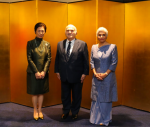You are here
The assassin’s false creed
Jan 06,2020 - Last updated at Jan 06,2020
MOSCOW — For an armchair warrior like US President Donald Trump, who received five deferments from serving in Vietnam, assassinations must look like a foreign-policy silver bullet. You take out your enemy’s leadership with a drone strike or a rifle shot and, presto, your problems are solved. In fact, there is no historical basis for believing that assassinations solve anything. But there are plenty of precedents that they make things far, far worse.
Assassinations are, in almost every case, desperate gambles, usually carried out not by statesmen but by committed ideologues. This has been clear at least since the “golden age” of the assassin, Europe and America in the late 19th century and early 20th century. During these decades, anarchists murdered two US presidents (James A. Garfield and William McKinley), a Russian czar (Alexander II), a Habsburg empress (Elisabeth, wife of Franz Joseph I), an Italian king (Umberto I), a French president (Sadi Carnot), and two Spanish premiers (Antonio Cánovas del Castillo and José Canalejas y Méndez).
The two great heroes of this movement of anarcho-assassins, Mikhail Bakunin and Prince Petr Kropotkin, were Russians, which is not surprising. After all, in the words of an anonymous Russian diplomat of the time, quoted by Georg Herbert zu Münster, 19th centurey Russia could be described as “absolutism tempered by assassination”. Bakunin and Kropotkin both embraced assassination, which they called “the propaganda of the deed”, or, as the Harvard cultural historian Maya Jasanoff more correctly called it in her luminous study The Dawn Watch: Joseph Conrad in a Global World, “propaganda by dynamite”.
Jasanoff was commenting on Conrad’s The Secret Agent, the Polish-English novelist’s darkly cynical story in which a purveyor of pornography, not some political fanatic, plots a terrorist atrocity. Such tactics, Conrad seems to suggest, are the tools of demented misfits, hollowed-out malcontents and the morally corrupt, not government leaders. And, in the end, the violent anarchy of Bakunin and Kropotkin yielded the Soviet Union, which in the Stalin era was just about the most totalitarian state the world has ever known. Though China’s Mao Zedong would certainly challenge that title, and with the advent of Big Data, facial recognition technology and artificial intelligence may enable its current President Xi Jinping to keep it.
And if Czarist Russia was a form of “absolutism tempered by assassination”, Japan in the 1920s and 1930s perfected a form of politics in which murder became the military’s chosen means of influencing government policy. Determined to eliminate civilian opposition to Japan’s invasion and takeover of China, extreme nationalist elements of Japan’s army and navy engaged in a series of assassinations to achieve their policy goals. Prime Minister Inukai Tsuyoshi, who negotiated the London Naval Treaty (which, in the eyes of the nationalists, gave Japan a status “inferior” to that of the United States and the United Kingdom), was murdered in 1932. Originally, the officers had also planned to kill Charlie Chaplin, whom Inukai had hosted at a reception earlier in the day.
The light sentences handed out to the assassins only encouraged more, and greater, political bloodshed. Although the plotters of the “February 26 Incident” failed to assassinate Prime Minister Keisuke Okada or to take Emperor Hirohito hostage, they did succeed in killing Finance Minister Takahashi Korekiyo (sometimes called Japan’s Keynes), and Admiral Saitō Makoto, one of Hirohito’s closest military advisers. Another, Admiral Kantarō Suzuki, was wounded. In a grim sense, these assassinations succeeded, because Japan’s militarists so intimidated the government and palace that their policies, in China and elsewhere, could no longer be challenged. The road to war, and Japan’s ultimate ruin, lay open.
True, some state-sponsored assassinations, and attempted assassinations, contain an element of personal vengeance. Stalin loathed Leon Trotsky, and was undoubtedly delighted when the Spanish Communist and Soviet NKVD agent Ramón Mercader buried an icepick in his one-time rival’s head. And Russian President Vladimir Putin has been accused of allegedly ordering the killing of former KGB operative Alexander Litvinenko by radioactive polonium in 2006 and the poisoning of Sergei Skripal, along with his daughter, who luckily survived their exposure to the Novichok nerve agent in 2018. Supposedly, he took their defection to London as a personal affront.
But the world’s democracies should not feel very self-righteous where assassination is concerned. It is easy to imagine that some wounded amour proper was behind US leaders’ persistent efforts to assassinate Cuba’s Fidel Castro, using everything from poison to exploding cigars. And it was a British attempt to assassinate Napoleon that led to a renewal of warfare in Europe after peace had been concluded with the Treaty of Amiens.
Two political scientists, Northwestern’s Benjamin Jones and MIT’s Benjamin Olken, have actually tried to quantify how misguided assassinations are as a matter of policy. They examined 298 assassination plots dating back to 1875 and discovered that success was no sure thing. Indeed, only 59 of the attempts ended with the target dead.
More to the point, Jones and Olken’s research bears directly on the assassination of Qassem Souleimani: They found that such targetted killings by governments do little either to deter war or to minimise it. So, as usual with Trump, the world may just have witnessed an empty, and potentially a very costly in the long run, gesture.
Nina L. Khrushcheva is professor of international affairs at The New School. Her latest book (with Jeffrey Tayler) is “In Putin’s Footsteps: Searching for the Soul of an Empire Across Russia’s Eleven Time Zones”. ©Project Syndicate, 2020.
www.project-syndicate.org












